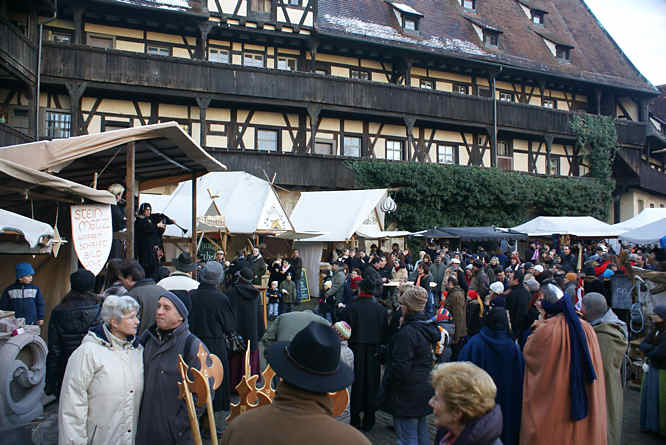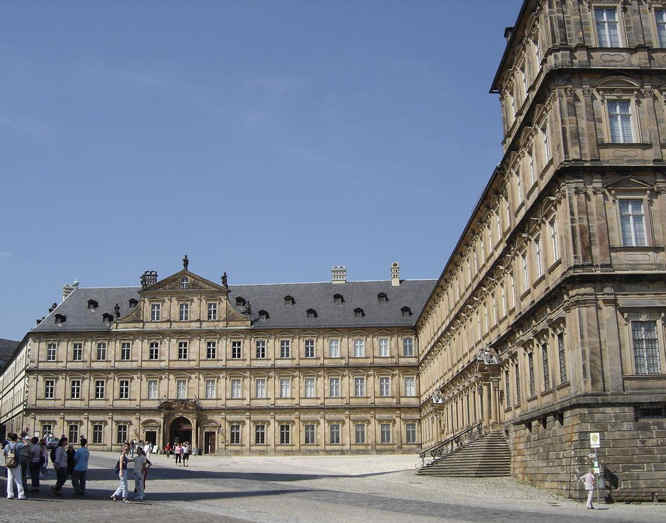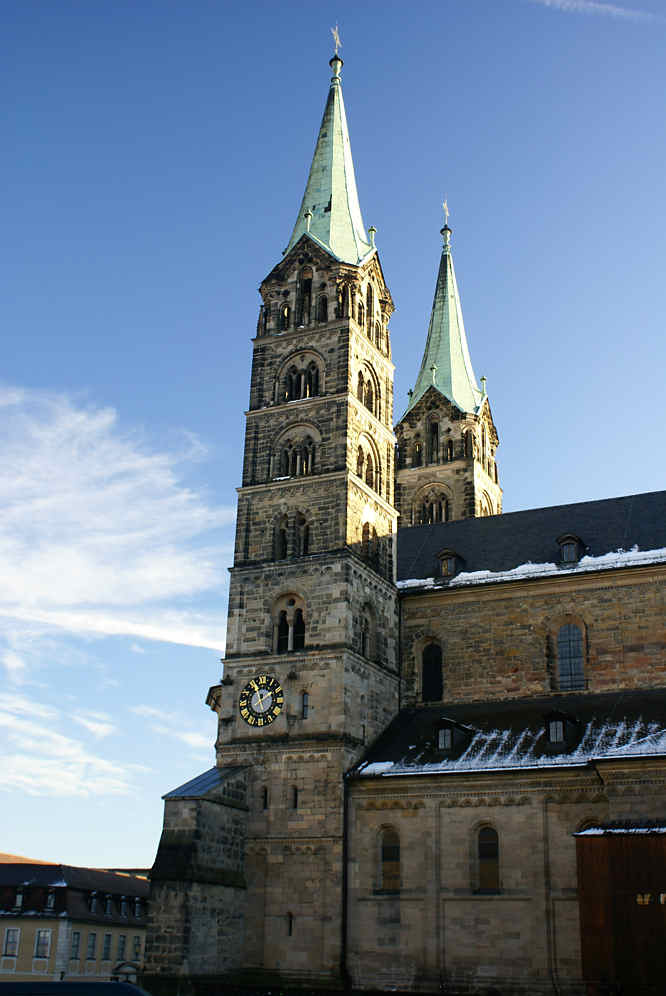Bamberg Medieval German Christmas Market
During the first two weeks of December a small medieval Christmas market is held in the 'old court' just off the 'Domplatz' square. The stall holders are dressed in medieval costumes. There are also re-enactors walking around dressed as soldiers in chain mail carrying spears and swords. Look out for the executioner. The children love it.

On stage period musicians using ancient unusual instruments play foot stomping traditional folk tunes. When we visited a group dressed as warrior monks played some great tunes using drums trumpets and strange black three horned bagpipes. The most of the stalls are under ancient canvas tents. Some have games like whack the rat for the younger customer to play.
The most of the stalls are under ancient canvas tents. Some have games like whack the rat for the younger customer to play. Traditional Bamberg sausages are sold. There are lots of old style craft items and wooden toys for sale as well as festive food. Unlike most Christmas markets entrance is not free. It goes towards paying for the musicians and actors. Your ticket includes free entrance to the City's History Museum.
The Old Court, was once directly connected with the cathedral. You walk through the beautiful carved stone gate built in 1573, to reach the inner courtyard which is surrounded by half-timbered buildings. The setting is enchanting and adds to the experience of being transported back in time.

Neue Residenz (New Residence & Rose Garden)
The Neue Residenz Palace was built in 1591 on the site of the old home of the Babenberg Counts. The palace was where the Prince Bishop and his administration lived and worked. They played a very influential role in the politics of the Holy Roman Empire. In the middle ages, the German Emperors of the Holy Roman Empire had no permanent capital, but traveled continuously within the boundaries of their realm to reassert their power and deal with their loyal and not-so-loyal subjects and noblemen.
Their vassals had to provide for decent accommodation for them and their staff. This is what the buildings around the Domplatz were used for. The Bishop's wealth is visible in the grand structure of the Residenz.
You can view the richly decorated interiors for a small charge but access to that attractively laid out flower garden and cafe are free. Walk through the main archway to view the garden. The balcony affords good views of the rest of the city and the Benedictine convent of St Michael on Michaelsberg that was founded 1015, secularised in 1803. Today, this magnificent building complex houses the Bavarian state library as well as the state gallery.
The four-winged complex of the New Residence was built in two stages. Firstly, the backwards two-winged section, which flanks the Obere Karolinenstrasse, was built from 1602 on in the Renaissance style under Prince Bishop von Gebsattel. Then, under Prince Bishop Lothar von Schonborn, the Baroque wings facing the Cathedral were built between 1697 and 1703 as a residence for the Prince Bishop by Leonhard Dientzenhofer.
You can visit the private apartments and staterooms, the Emperor's Chamber, the Chinese room and valuable collections of paintings. Take time to walk around the charming ancient streets and alleyways of the west bank Seven Hills district. From the Domplatz walk up Obere Karolinenstrasse towards Jacobsplatz and just explore the back streets. Then walk down hill towards the Old Town Hall (Alte Rathaus)

Bamberg's Kaiserdom (Emperor's Cathedral)
The Kaiserdom can be found on the west bank of Bamberg on the Domplatz (Cathedral Square) overlooking the old town on the island. It's four spires can be seen for miles around. Originally built in 1012, it burned down twice before finally being rebuilt in the sandstone you see today during the 13th century. Like the town the Cathedral is a mixture of styles, starting with the Romanesque and transitioning to the Gothic, with the four different towers highlighting the different architectural styles. It has an unrivalled collection of statues.
The most famous of all these sculptures is the Bamberg Rider (Bamberger Reiter) created by an unknown French-trained sculptor, of an unknown emperor. The Romantics of the time saw the sculpture as the idealised German emperor, and this image was seized upon by the Nazis a symbol of Germanic perfection. During the Third Reich the image of the Bamberger Reiter could be seen all over Germany.
Travel books

